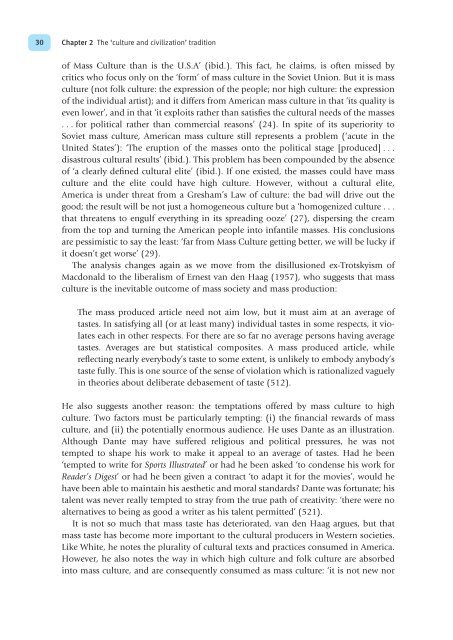Cultural Theory and Popular Culture
Cultural Theory and Popular Culture
Cultural Theory and Popular Culture
You also want an ePaper? Increase the reach of your titles
YUMPU automatically turns print PDFs into web optimized ePapers that Google loves.
30<br />
Chapter 2 The ‘culture <strong>and</strong> civilization’ tradition<br />
of Mass <strong>Culture</strong> than is the U.S.A’ (ibid.). This fact, he claims, is often missed by<br />
critics who focus only on the ‘form’ of mass culture in the Soviet Union. But it is mass<br />
culture (not folk culture: the expression of the people; nor high culture: the expression<br />
of the individual artist); <strong>and</strong> it differs from American mass culture in that ‘its quality is<br />
even lower’, <strong>and</strong> in that ‘it exploits rather than satisfies the cultural needs of the masses<br />
. . . for political rather than commercial reasons’ (24). In spite of its superiority to<br />
Soviet mass culture, American mass culture still represents a problem (‘acute in the<br />
United States’): ‘The eruption of the masses onto the political stage [produced] . . .<br />
disastrous cultural results’ (ibid.). This problem has been compounded by the absence<br />
of ‘a clearly defined cultural elite’ (ibid.). If one existed, the masses could have mass<br />
culture <strong>and</strong> the elite could have high culture. However, without a cultural elite,<br />
America is under threat from a Gresham’s Law of culture: the bad will drive out the<br />
good; the result will be not just a homogeneous culture but a ‘homogenized culture . . .<br />
that threatens to engulf everything in its spreading ooze’ (27), dispersing the cream<br />
from the top <strong>and</strong> turning the American people into infantile masses. His conclusions<br />
are pessimistic to say the least: ‘far from Mass <strong>Culture</strong> getting better, we will be lucky if<br />
it doesn’t get worse’ (29).<br />
The analysis changes again as we move from the disillusioned ex-Trotskyism of<br />
Macdonald to the liberalism of Ernest van den Haag (1957), who suggests that mass<br />
culture is the inevitable outcome of mass society <strong>and</strong> mass production:<br />
The mass produced article need not aim low, but it must aim at an average of<br />
tastes. In satisfying all (or at least many) individual tastes in some respects, it violates<br />
each in other respects. For there are so far no average persons having average<br />
tastes. Averages are but statistical composites. A mass produced article, while<br />
reflecting nearly everybody’s taste to some extent, is unlikely to embody anybody’s<br />
taste fully. This is one source of the sense of violation which is rationalized vaguely<br />
in theories about deliberate debasement of taste (512).<br />
He also suggests another reason: the temptations offered by mass culture to high<br />
culture. Two factors must be particularly tempting: (i) the financial rewards of mass<br />
culture, <strong>and</strong> (ii) the potentially enormous audience. He uses Dante as an illustration.<br />
Although Dante may have suffered religious <strong>and</strong> political pressures, he was not<br />
tempted to shape his work to make it appeal to an average of tastes. Had he been<br />
‘tempted to write for Sports Illustrated’ or had he been asked ‘to condense his work for<br />
Reader’s Digest’ or had he been given a contract ‘to adapt it for the movies’, would he<br />
have been able to maintain his aesthetic <strong>and</strong> moral st<strong>and</strong>ards? Dante was fortunate; his<br />
talent was never really tempted to stray from the true path of creativity: ‘there were no<br />
alternatives to being as good a writer as his talent permitted’ (521).<br />
It is not so much that mass taste has deteriorated, van den Haag argues, but that<br />
mass taste has become more important to the cultural producers in Western societies.<br />
Like White, he notes the plurality of cultural texts <strong>and</strong> practices consumed in America.<br />
However, he also notes the way in which high culture <strong>and</strong> folk culture are absorbed<br />
into mass culture, <strong>and</strong> are consequently consumed as mass culture: ‘it is not new nor
















